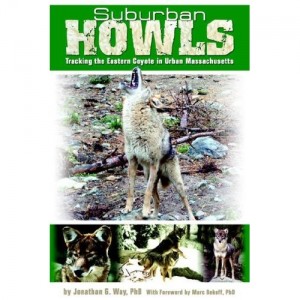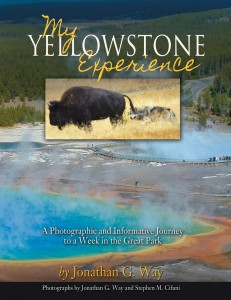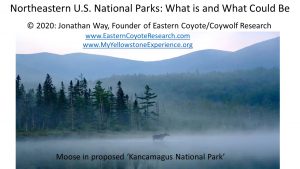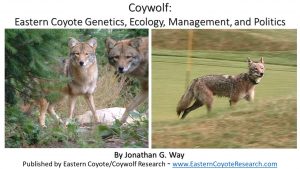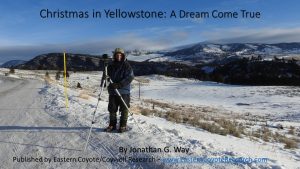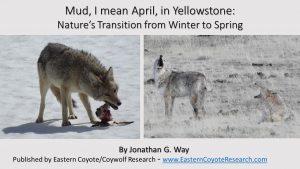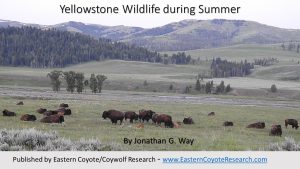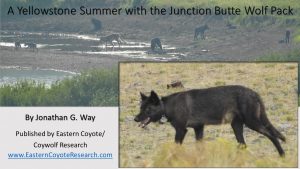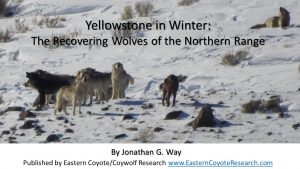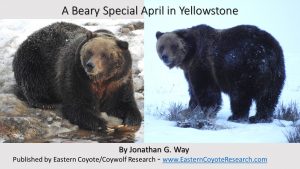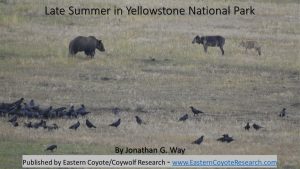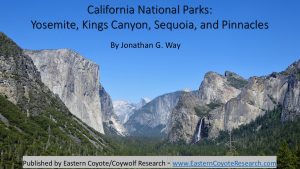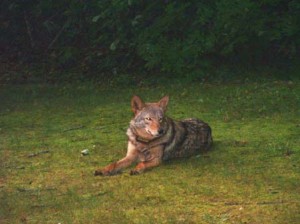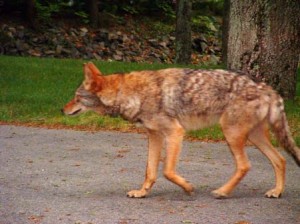I apologize in advance but not all of the links work from 2007 to 2009. Some of the files (especially Field Updates from July 2007-2009) were lost when my old hosting company disappeared. I comment below where the links actually work to save you some time. Additionally, most articles from the internet will still be valid as these links weren’t affected when I switched hosting companies. Again, it is mostly the older field updates that were lost. Most of the links from the second half of 2009 (i.e., the top half of this page) work properly:
December 2, 2009. Did anyone see or take pictures of the “coyote” at the Airport Rotary on November 17. There is a picture in yesterdays update below this one (Nov 30) from the Cape Cod Times. The “coyote” looks exactly like Sill, who seems to have been displaced last fall in Marstons Mills by a new male. He was 9.5 years at the time and would be 10.5 now and likely a transient, similar to Casper (paper soon appearing in Canadian Field-Naturalist). I need a side angle picture of that animal to look for his smallish black collar. He had an ear notch just like in the picture from the rotary. Thank you in advance for any help on this. Update 22 January, this animal was indeed Sill. How amazing. He is now almost 11 years old and is likely a floating nomad like Casper was which is detailed in a peer reviewed paper coming out in a forthcoming issue of Canadian Field Naturalist. His collar’s battery is surely dead from old age. I want to thank the photographer (who wishes to remain anonymous) for verifying the collar. Pretty amazing that I figured that it was Sill solely based on that picture of him. Good luck old man!
November 30, 2009. How many “coyotes” (really coywolves) are in Massachusetts and on Cape Cod? Updated Sept 15, 2010. Link No longer in service b.c of my old website being down but I estimate that the late winter population (when estimates are supposed to be made) to be about 200-300 on Cape Cod. Note: please see my Life Cycle page on my new website (here) which will answer that question.
November 30, 2009. Editorial: Hunting does not make coywolves avoid people.
November 20, 2009. Article on me and my nature tourism company in Animal Tourism online magazine.
November 17, 2009. Great quote: “Kindness and compassion towards all living beings is a mark of a civilized society. Racism, economic deprival, dog fighting and cock fighting, bullfighting and rodeos are all cut from the same defective fabric: violence. Only when we have become nonviolent towards all life will we have learned to live well ourselves.” – Cesar Chavez, civil rights and labor leader, founder of the United Farm Workers. My comment: What about coyote and coywolf hunting?
November 16, 2009. Another shameful article on hunting “coyotes” (really coywolves) in Mass. My response:
Your recent article on hunting “coyotes” (really coywolves) in Mass is filled with no scientific data as Mass. Fish and Wildlife repeatedly defends the stance to allow a minority of people to legally slaughter a social, intelligent species. The article states that baiting and shooting them at night is the most effective way to hunt them yet that is supposed to be when they are active to avoid people. There is absolutely, positively, no scientific data to show that shooting them makes them more wary. How can you get shot and killed and learn to fear man, especially when you are feeding on a bait bucket at night? That might teach a coywolf (if the hunter misses) to actually be more active during the daytime and live closer to people where hunting is illegal. I really don’t think anyone from Fish and Game has ever been to a large national park where hunting is not allowed. Even there, very rarely are coyotes or wolves ever a danger to people and they self limit their own numbers through their territoriality. I just don’t buy this hunting argument – I do buy the argument to protect pets (leave cats inside, leash dogs) and not encourage interactions from occurring.
Having actually studied and radio-tracked them for 12 years in a suburban environment I have learned that collared family groups are elusive around people and generally avoid people while literally living and traveling among human neighborhoods. Leaving coywolves alone (not hunting them) allows them to set up large territories which they guard and keep other coywolves out of. Negatively conditioning (chasing, yelling at; but not killing) these animals will help the local coywolves learn to avoid people while they limit their own numbers. I am appalled how one agency can be so pro-hunting and allow anyone to slaughter unlimited numbers of them without having any evidence that the slaughter is doing anything to prevent interactions from occurring. In other words, I bet no more than 2 or 3 of the 500 or so that are killed in MA per year are even remotely dangerous to humans and the few problem causing animals (like at a farm) can be removed humanely. But the lesson of course, is ‘Shoot first, ask questions later’.
November 14, 2009. 2009 Holiday Sale. Color version of Suburban Howls just $19.99 through Christmas. A great Holiday present. Visit my Store or to learn more about my book visit this page.
November 5, 2009. Check out Wildlife Art Journal, by Todd Wilkinson. A cool site I recently became aware of.
November 4, 2009. Quote of the day emailed to me from an employee of the state of Virginia pasted exactly as stated: “Dr. unfortunately ,your views on coyote’s are somewhat skewed. They are wanton predators. Who when given the chance will even kill their own kind for food. The number of whitetail fawns they kill per den is almost unbelievable. Please research this at your convenience and find out for yourself.” I won’t speculate what branch of the VA government he works for but this seems to be a commonly held belief with absolutely no scientific evidence to back it up. For one, dens very rarely have any food near them and I have heard all sorts of old wives’ tails of cats, cat collars, deer fawns, and others at known den sites. I don’t know where this tale originated from but food is regurgitated to pups and eaten away from the den. I have already covered the ecological value of these guys and won’t bore you with more rhetoric here.
November 3, 2009. Terrible news: 2 coyotes kill a young lady (19 yr old) in a National Park in Nova Scotia. Articles of potential interest are here: article with me quoted 1, article with me quoted 2, article 3, article 4, and google results of this tragedy.
Approximately a week after the tragedy, the details of the attack still haven’t been released and I don’t want to speculate anything. I have no“classified” information either. However, the most relevant information that I can point out is that I have studied around 50 coywolves in Eastern MA over the past decade. All individuals live(d)amongst people and avoid them on a daily basis. And they have done this for50-75 years in the Northeast. If they wanted to attack someone, they could do it(collectively as a population) anytime, and just about anywhere in the NE. The relative danger is still extremely small and this unfortunate instance shouldn’t change anything except to alert everyone that this is a wild predator that we need to at least be aware of and not habituate to people. As managers, wildlife advocates, or even lay people,we need to stress that the worst thing that can happen is habituating these animals to people by doing things like feeding them,etc.
From what I have read thus far the authorities up there have done a great job considering the awful news. They aren’t calling for hysteria, are only looking for the culprit ‘coyotes’ (really coywolves) to kill, and are saying all the right things about their normal behavior and how unusual this attack was.The comments under some of the articles (especially article 2) are predictable.
October 14 – November 2, 2009. Besides Oct. 20, I have been unable to update my webpage due to my website hosting’s upgrade issues. Not being a computer expert, I have no idea what the problem was but that really stunk given the terrible news (and my delayed response) regarding the update above this one, dated Nov. 3.
October 20, 2009. Frustrating article in Boston Globe Metro West on ‘Coyote’ hunting. It doesn’t interview anyone (99% of the population) that doesn’t hunt and doesn’t discuss any of the positive benefits of Coywolves. It really is straight from the 1800s when we were trying to exterminate wildlife. Click on date to read article and my response. Update September 18, 2010, link no longer available…
September 25, 2009. A national article today describes the benefits of Michael Vick’s dog fighting case in causing more awareness to this now illegal, inhumane “sport”. However, in just 1 week hunters in Massachusetts will legally be able to slaughter coywolves using dogs, certain traps, bait (possibly the most ridiculous as they are attracked to a food source, even though state agencies advocate not feeding wildlife), bows, specialized guns, and electronic calls to attract them; and they can do this in unlimited numbers with their $30 hunting license. This is allowed to occur, more or less, in every state where coywolves and coyotes live (which is all but Hawaii when combining the 2 animals). It is time for the National Canid Protection Act to make these unnecessary acts illegal.
September 24, 2009. Please help fund my research. Consider taking a wildlife guided tour led by myself on either Cape Cod or potentially Yellowstone National Park.
September 24, 2009. A second study, by Dr. Roland Kays of the New York Field Museum has confirmed that the eastern coyote is really a coyote x wolf hybrid. Our paper has been accepted to the journal Northeastern Naturalist for quite a few months now (i.e., in press) but it has yet to be published in the journal. Here are a couple links to Dr. Kays’ study: This google search page has four articles. Here are two of them: Article 1 and Article 2.
September 18, 2009. 2006 figures available for wildlife watching and hunting values in Massachusetts. Hunting = 73,000 people and $71 milllion; Wildlife Watching = 1,919,000 people and $755 million. Despite WW being over 10 to 1 greater, there are no designated non-hunting public wildlife watching areas in my state. How undemocratic. Please visit my Support page to help the wildlife watching cause.
September 16, 2009. There has been lots of controversy surrounding hunting gray wolves in the Rocky Mountain states of Idaho and Montana. Much of this debate is continually covered and updated (look at prior posts if you don’t believe me) on Ralph Maughn’s website . You can probably imagine that I am against simply letting people kill gray wolves for recreational purposes. It is amazing how state agencies don’t recognize the social, sentient nature of these canids, similar to coywolves here in the Northeast. However, there are a couple of important notes here. Those 2 states have quotas which no Northeastern state has – rather they (and I have always said this) allow an unlimited slaughter of the animals including in my homestate of Massachusetts. Furthermore, the 2 western states have a bag limit of 1 wolf per hunter and charge for a tag ($19 per tag in Montana) per wolf. I am convinced that Northeastern states, who don’t even make hunters buy an extra ‘coyote’ tag (rather they can kill unlimited numbers with their about $30 general license) are trying to put themselves out of business and greatly anger the vast majority of citizens who recognize the importance of maintaining predators in a healthy ecosystem. It makes no sense as hunting season is fast approaching here in Massachusetts (it starts the Monday after Columbus day).
September 4, 2009. Another “record” year of shooting coywolves in Massachusetts. This year apparently 489 were killed which bettered last years record killing of 422. I recently had this article about coywolves (still called ‘coyotes’ until our paper comes out within the next couple of months proving they are hybrids with wolves) killing sheep in Dartmouth forwarded to me and that is where I found the 489 stat. I thought that the wildlife biologist said all the right things about coexisting with these animals; it is just unfortunate that the law allows anyone with a $30 license to blow away unlimited numbers of them for almost half the year.
And just on the same day I read this great article about the stupidity of shooting wolves in the west. Maybe our enlightened wildlife department in Massachusetts (as well in other states) will one day see more to coyotes/coywolves than their constitutents being able to slaughter them for half the year. There is no info yet available on Mass Wildlife’s homepage (or on their harvest/kill information) about the record kill, probably because of public outcry with the information. So if anyone digs in and can get more stats on where they were all killed, etc., please email that information so I can post it. I hope you will join me in recommending the National Canid Protection Act, something I continue to advocate for. Hopefully Congress will one day implement it as hunting these social, intelligent animals is unneeded except in rare circumstances like possibly the animal(s) involved in the Dartmouth attack although I know little about how protected the livestock really were.
August 24, 2009. An article for your interest: How to Live With Coyotes (Coy-Wolves) in the Suburbs by Marie Thomas.
August 6, 2009. A new publication is available on my Publications Page. Enjoy!
June 30, 2009. Pictures of Eastern Coyote/Coywolf Ice! I won’t give the location but he is like a national park coyote in the early morning and at night as he isn’t super scared of roads and uses them to travel, and simply steps to the side of a road when a car passes. He has the typical red wolf-like look given their hybrid status between western coyotes and eastern wolves. Enjoy! Note: I am about 20 feet away from him on both images and he has no interest in me; he seems to view humans neutrally and just goes on his own way. Unfortunately others might deem him a problem animal for no reason.
June 27, 2009. I am returning from a very successful International Urban Wildlife Conference where I co-presented two talks: Eastern coyote movement patterns: lessons learned in urbanized ecosystems and Coyote populations in urban ecosystems: ecosystem services and trophic considerations. The talks went very favorably and other talks criticized the utilitarian perspective in how the state currently views wildlife – I didn’t even need to (and purposely didn’t). It now amazes me even more that I still don’t have permits to do this research as Massachusetts Fish and Game makes it so difficult to simply study wildlife. It is pathetic and needs to change. Not having permits to trap the past 4.5 months has been irreversible and is unacceptable especially since they know full-well that I want to make this a long-term study (this is the 12th year). However, no one (as of now) will step up and fight them like I am now doing. One day society will look back negatively to how we treat wildlife – to say I haven’t paid for speaking up against coyote hunting is a downright joke.
June 21, 2009. Using Dogs to Hunt Coyotes. This is awful, but legal in most states – certainly here in Massachusetts. Note: the video is graphic but a must watch. This needs to end and yet again illustrates the change that needs to occur within state fish and game departments!
June 21, 2009. On a somewhat unrelated note, I just watched a Nature PBS special on killer whales and early modern whalers in SE Australia cooperatively hunting baleen whales together. It was fascinating as the killer whales would go out of their way to alert their fellow humans to the hunt. They would then share the prize. I feel like many of us have lost the brotherhood that fellow side-by-side hunters (e.g., wolves, humans) used to have. Unfortunately, all state wildlife agencies seem to view wildlife (even our fellow predators like mountain lions, wolves) from a maximal utilitarian viewpoint. I think that is one factor in creating the divide in modern wildlife management – many, even hunters, don’t view predators like eastern coyotes like they do our prey (deer, rabbits) and don’t think they should be treated as such.
June 18, 2009. Bison Management around Yellowstone National Park. Bison management is almost worse than coyote management nationwide. Our tax dollars are used to slaughter bison around Yellowstone even though brucellosis (a disease that causes cattle to abort their young) has never (NEVER) been transferred from bison to cattle and despite a higher percentage of elk carrying the disease than bison. As the comment says, it is all about the Montana Dept. of Livestock’s brutal and disproportionate control over wildlife. To kill bull bison, which can not even pass on the disease (it can only be passed on when cattle eat the afterbirth of an infected female bison), is a joke. These people should go to jail for abusing our national heritage. Bison should be treated like a wild animal like all others in this country. What a shame. Read on…
June 16, 2009. Please Consider Donating to ECR – New button in Support ECR Link.
June 11, 2009. Crazy About Coyotes. I was interviewed by Phil Brown, editor of the Adirondack Explorer.
June 10, 2009. Brief Field Update, Permit nightmare of 2009, and Job Search – Help Needed.
May 24, 2009. New paper on my Publications Page: Assessing Deer Abundance and Distribution in the town of Barnstable. My hometown is unique in that there are not many deer, in contrast to most of the eastern United States. The paper states that the state and/or town must eliminate doe/antlerless tags for 5-10 years to allow deer to recolonize areas where they do not exist in the town. I hope these agencies listen to the recommendations brought forth in this paper.
May 23, 2009. Yet another peer-reviewed paper accepted. This is over 20 as me (Jon Way) being first author! This paper is on Casper (ID #9804). I wrote a tribute to her in my book. She ended up getting shot and killed after my book was published.
May 20, 2009. Please help create the “Barnstable Wildlife Watching Area” by making the town of Barnstable’s public lands (watersheds, conservation areas, open space) dedicated exclusively to wildlife watching. Click here to learn more.
May 7, 2009. Yet another peer-refereed article available on my publications page. Update May 14: Another paper accepted.
April 28, 2009. Yellowstone Spring Trip: What an amazing amount of wildlife in a short period of time. I have included 10 pictures of wild gray wolves in this link. I literally see more wolves in 1 week in Yellowstone than I do deer in 1 year on Cape Cod. Simply Amazing!
April 18, 2009. Click here for a great article on the “War on Predators” by George Wuerthner, a hunter and conservationist. It says exactly what I have always said about how state fish and game agencies nationwide, from Massachusetts to Wyoming, manage their predators for maximal exploitation and use things, such as “coyote’s have larger litter sizes when exploited” to justify the unlimited slaughters (i.e., no bag limits) which their management regulations allow. State agencies, judging from their management practices, seem to give no thought as to the ecological implications of their management plans. Again, that is why I recommend the National Canid Conservation/Protection Act. A case in point about this unlimited slaughter is the state of MA’s response to a letter written on my behalf to the state. The letter essentially counteracts all of my management recommendations for coyotes with a utilitarian, maximal exploitation perspective and indirectly ignores a growing body of literature (including some of my publications – see link below dated March 16) that describes predators such as coyotes as sentient, social, intelligent and playful beings. Furthermore, the state of MA seems to ignore the 2/3 majority referendum in 1996 that made baiting and hounding illegal for bobcats and bears – you would think that the average person wouldn’t want coyotes killed that way too but because coyotes weren’t on the ballot referendum you better believe Mass Wildlife will allow these unethical practices to continue. This is disappointing given that I agree with the state’s (and my) point #7, about non-lethal alternatives and education to better coexist with coyotes.
If you love animals and like to learn from them you need to visit campingfunzone.com you will find a lot of great information about them.
March 16, 2009. Five more peer-reviewed papers related to my eastern coyote research accepted into journals! Click on date to visit Publications Page. Update April 5: 2 scientific papers are now in print: (1) Social and Play Behavior of Eastern Coyotes, and (2) Movements of Transient Coyotes in Massachusetts.
March 7, 2009. Toward an era of positive attitudes and bridging the gap with perceived “enemies”
February 7, 2009. Annual and Quarter 3 2008 reports available on my publications page. Update Feb. 28. I am meeting personally (see March 7 update) with Mass Wildlife head representatives on Monday March 2 as I am going to directly get the permit for the Cape Cod research (i.e., I will be Principal Investigator) and my colleague Eric Strauss will continue to be PI of the Boston-area study. Wish me luck!
February 8, 2009. I just received this email from a concerned citizen. I receive emails like this commonly since concerned citizens have no other way to vent their anger with coyote management (or lack thereof) since just about all states do nothing to stop this type of slaughter within their jurisdiction.
February 4, 2009. Please consider donating to ECR. I am in the process of buying a Swarovski spotting scope which will cost around $2000. I desperately need your financial help to make this possible. I need the scope to augment my direct observations of coyotes/coywolves and at Yellowstone National Park. Please email easterncoyoteresearch@yahoo.com if interested. I can give you my home address and/or I can email you an invoice via paypal and you can securely donate via credit card whatever amount you wish to give. Thank you in advance for any consideration of this request!
January 19, 2009. Update Feb. 4. Winter-Spring Ongoing Field Update. New Captures: Stub and Ice. Summary of radio-monitored animals (10 being tracked on the Cape, 2 off-Cape, and 4 are no longer in radio-contact range including “famous” coywolf Sill from Marstons Mills). Note: Pictures are added to the bottom of the text. Update Jan. 25: Ice and Stub updates at bottom of text. Update Feb. 4: Ice news; Marstons Mills news.
February 2, 2009. Petition submitted to protect wolves and allow wolf recovery in the northeast. Click here to go to the Publications section of this webpage to read the 17 page petition.
January 9, 2009. Cape Cod Times article: State says don’t fence in Cape coyotes. A fairly balanced article describing more of my woes with getting state approval. Maybe one year someone will look beyond their shadow and figure out a way for this to happen, like public land in the town in a less developed area (like the Marstons Mills Airport area). I will only add one comment and leave the rest for the article… Update Jan 11: Cape Cod Times editorial opposing my plan and critiquing my open advocacy of the animal (coywolves). Interesting rationale from a newspaper. I am not sure if I have the same respect for them and their lack of perspective on the issue.
Update January 11, 2009. During the crazy day of Jan. 9, 2009, as I was teaching in high school, and dealing with the barrage of news about the captive coyote situation (I had no idea I was even on the radio and TV until late that evening), we captured a new coywolf. I am just doing a brief update here but it was a mangy male from Cotuit. He weighed an amazingly large 39.3 lb given that he was emaciated and was missing fur from the back half of his body. We are going to rehabilitate him (not at my house!!!) for about 1.5 months then release him. His name will be Stub given that his tail was broken likely do to frostbite from a lack of fur. We hope to be able to monitor his survival after he receives medical treatment. As the Cape Cod Times reports (see below Jan. 11 update) I guess I am not being objective enough to name him and hope that he survives. It is like all of the passionate biologists on nature channels don’t also love their study subjects which they invest their lives too study, often (like me) with hardships, like a lack of resources or in difficult circumstances (locations). I bet you would be hard pressed to find anyone that didn’t have my passion that studied a particular animal for as long as I have. Maybe we are all just nut-jobs!
